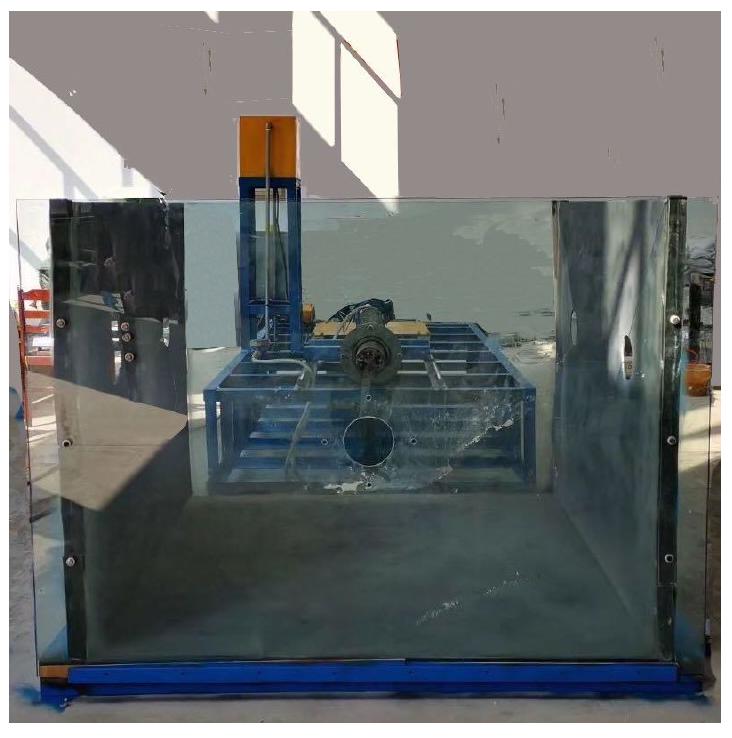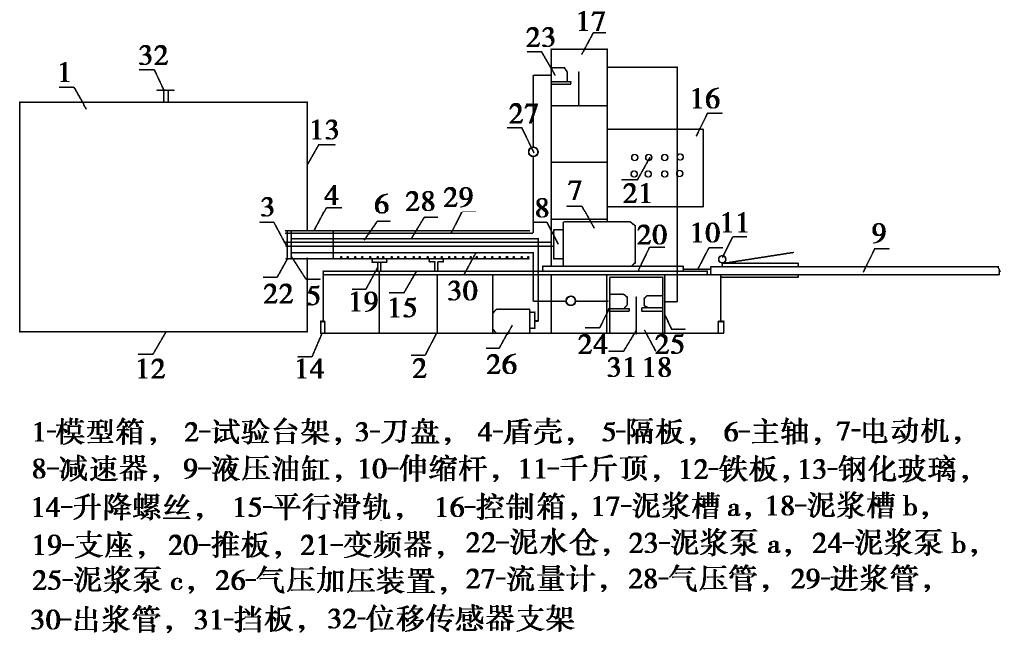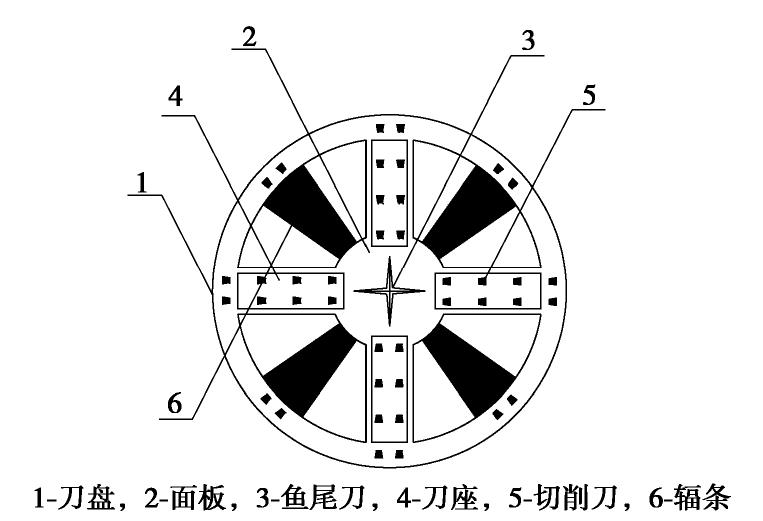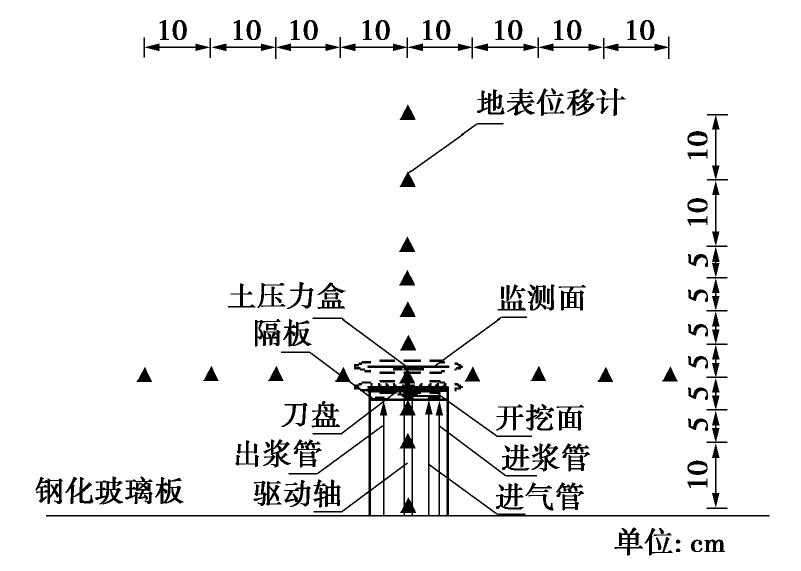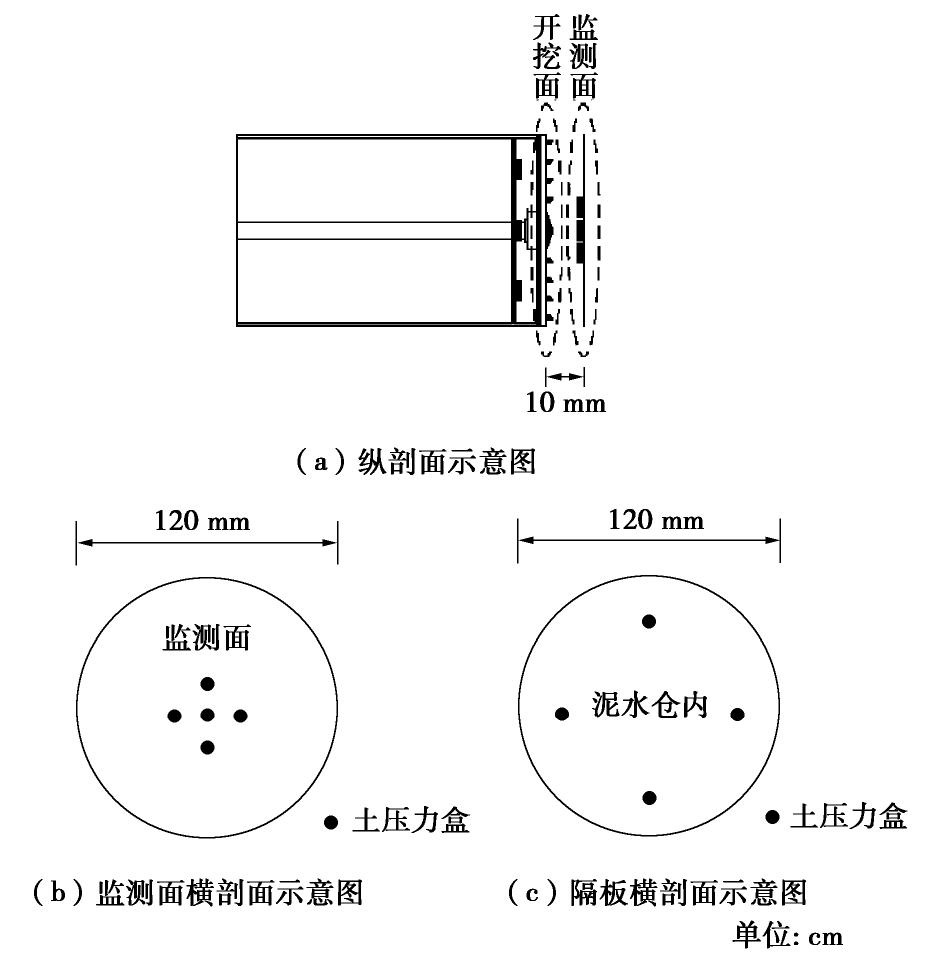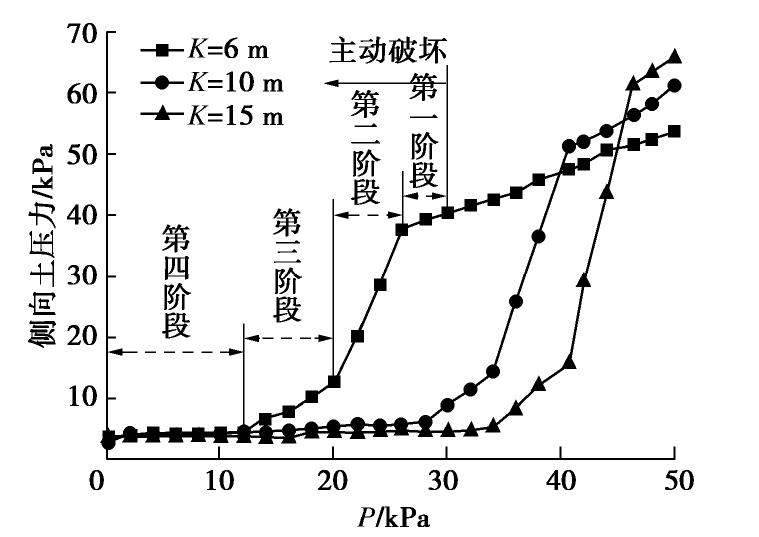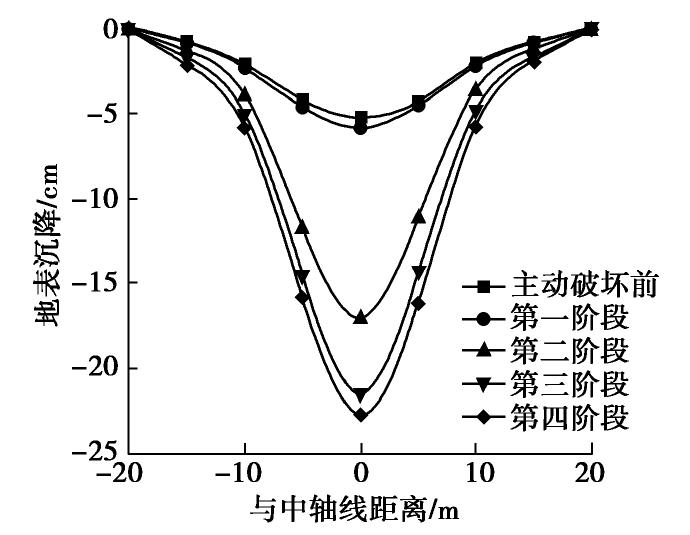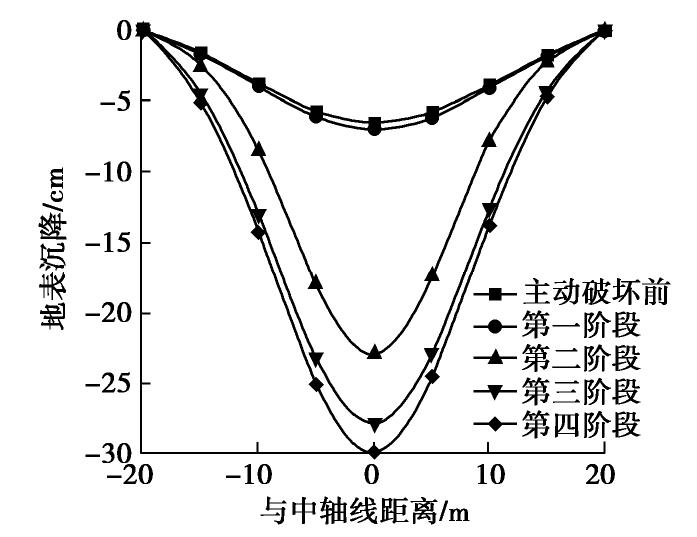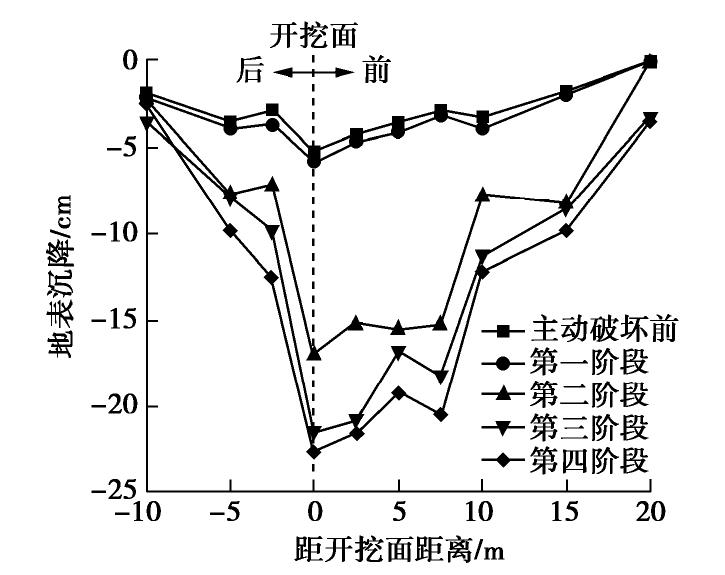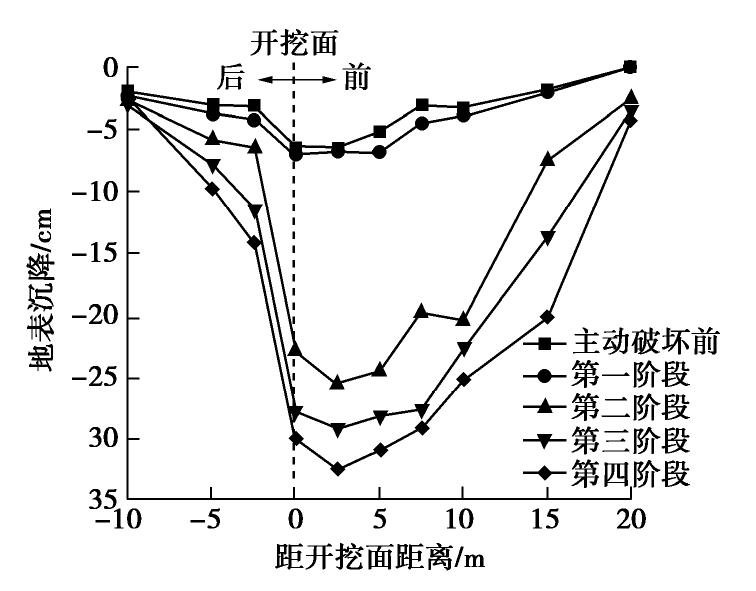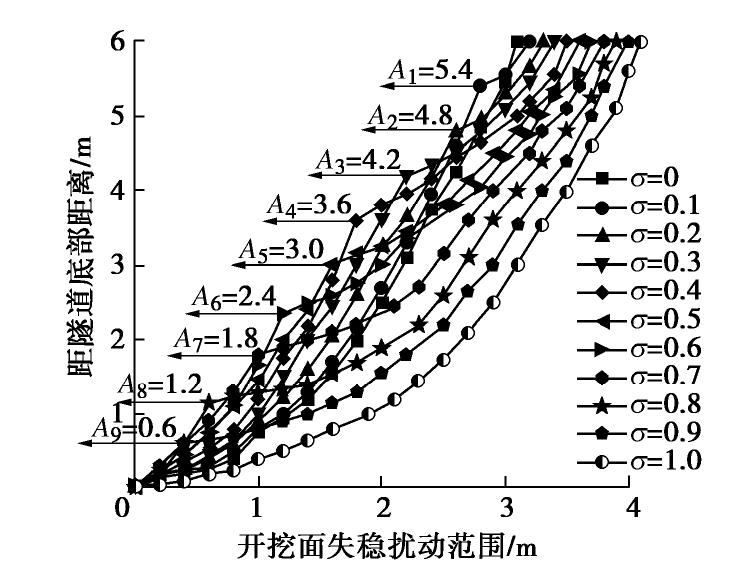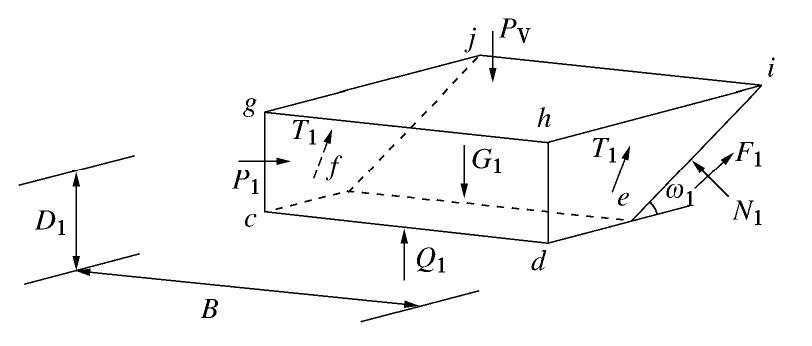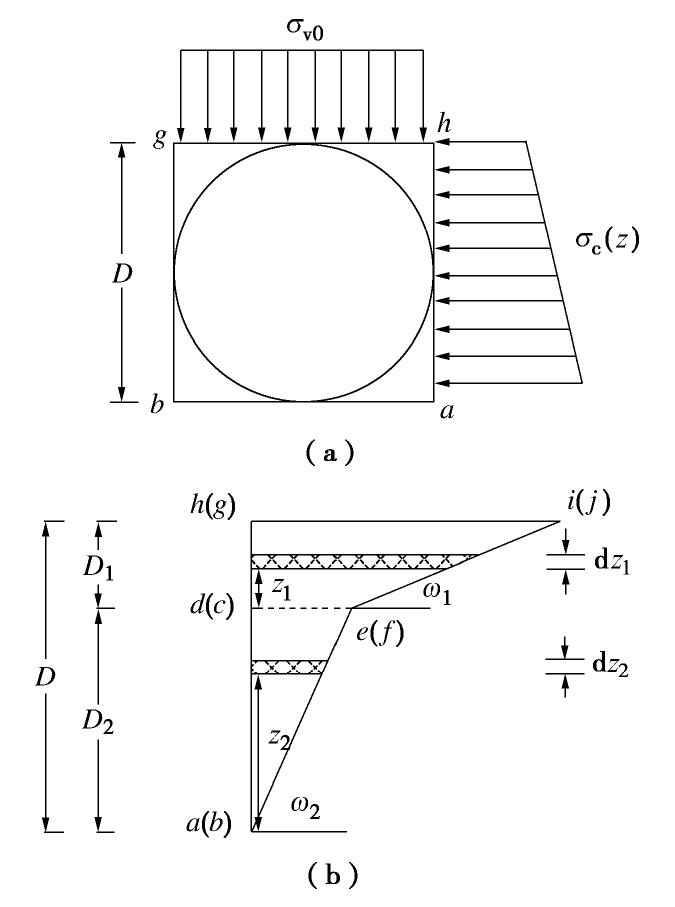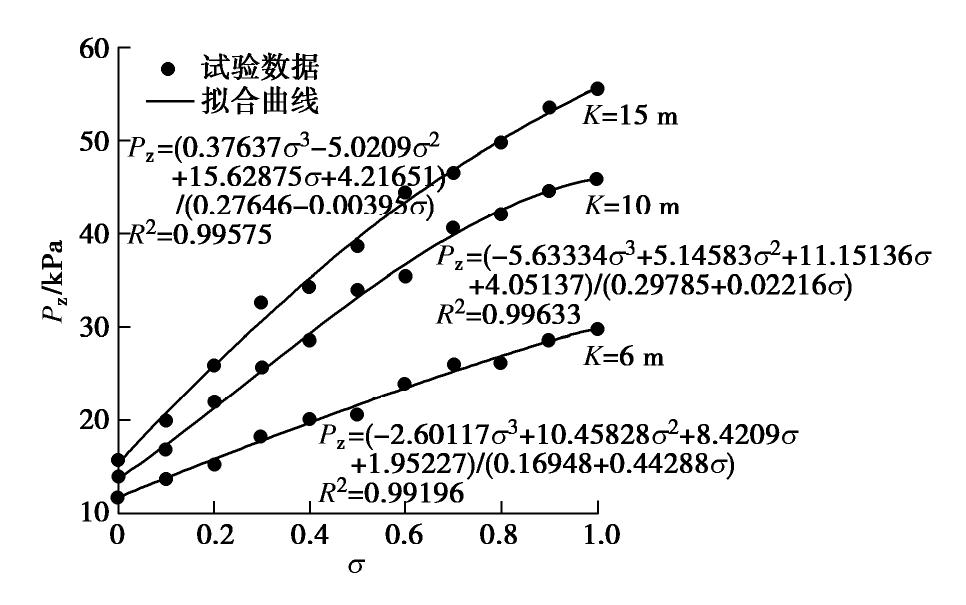Model tests on stability and ultimate support pressure of shield tunnel in sand-gravel composite stratum
-
摘要: 砂-砾复合地层盾构掘进时支护力过小极易导致开挖面前方土体发生主动破坏,造成地表沉降。定义砂-砾复合地层σ(盾构开挖面内粉细砂高度与盾构机刀盘直径的比值),并通过试验分析了σ对极限支护力、地表沉降和开挖面失稳扰动范围的影响;基于模型试验和筒仓理论,建立了适用于砂-砾复合地层的盾构隧道开挖面极限支护力计算模型,将σ引入模型中并推导出其计算公式。研究结果表明:①随着开挖面支护力的减小,开挖面发生主动破坏时侧向土压力-支护力曲线表现出不敏感阶段、快速下降阶段、缓慢下降阶段、稳定阶段4个阶段的规律;②破坏时σ越大,越不利于地表沉降控制;③与传统模型相比较,通过试验得知破坏面近似为折线,更贴合砂-砾复合地层的变形破坏模式;④极限支护力随着σ的增大呈近似线性的函数关系增长,覆土深度较大时,应充分重视σ对极限支护力带来的影响;⑤埋地层中,覆土深度对极限支护力的影响更加明显,需引起重视。研究结果对确定砂-砾复合地层开挖面的极限支护力有重要的指导意义。Abstract: For the shield-tunneling in sand-gravel composite stratum, if the support force is too small, it will easily lead to active destruction of soils in front of the excavation face and cause surface settlement. A parameter for the sand-gravel composite stratum is defined, that is the ratio of height of silty fine sand in excavation face to the cutter diameter of shield machine. Its effects on the ultimate support force, surface settlement and disturbance range of excavation face instability are analyzed. Based on the model tests and the silo theory, a computational model for the ultimate support force of excavation face of shield tunnels is established. It is introduced into the model, and the relevant formula is derived. The results show that: (1) With the decrease of the support force of the excavation face, the lateral earth pressure-support force curve exhibits the laws of insensitive stage, rapid declining stage, slow declining stage and stable stage. (2) The larger the value of σ is, the less conducive the control of surface settlement is. (3) Compared with that by the traditional model, the failure surface being approximately a broken line by the proposed method is more suitable for the deformation and failure mode of sand-gravel composite stratum. (4) The ultimate support force increases in an approximate linear functional relationship with the increase of σ. When the depth of overburden is large, the effects ofσ on the ultimate support force should be paid more attention to. (5) In the shallow stratum, the effects of overburden depth on the ultimate support force are more obvious, and need to be paid attention to. The research results have important guiding significance to determining the ultimate support force of excavation face in sand-gravel composite stratum.
-
0. 引言
随着地下空间的大规模开发,盾构施工面临的土层条件更加复杂多样。泥水平衡盾构在砂-砾复合地层中掘进时,因地层松散、无黏聚力等特点,土体易因开挖面支护力不足而造成失稳破坏,给工程带来极大的影响[1]。因此,合理确定砂-砾复合地层条件下盾构隧道开挖面支护力对工程具有重要的意义。已有众多学者通过理论分析和模型试验等方法,对合理确定盾构隧道开挖面支护力以及开挖面稳定性问题进行了研究。Horn[2]最早基于Janseen[3]的筒仓理论提出三维楔形体计算模型的概念,该模型为开挖面稳定性极限平衡模型的演化奠定了基础;Jancsecz等[4]对该理论进行了完善,并建立了三维楔形体模型;Anagnostou等[5-6]将该模型用于开挖面的稳定性研究,对开挖面极限支护力及其主要影响因素进行论证分析;赵明华等[7]对三维楔形体模型进行修正,提出了适用于上硬下软地层的计算模型并得到极限支护力表达式;陈仁朋等[8]通过大尺寸物理模型试验研究了干砂地层中不同埋深条件下盾构开挖面稳定性问题;吕玺琳等[9]研究了饱和圆砾地层盾构隧道开挖面支护压力不足导致的渐进失稳破坏过程;宋洋等[10]揭示了浅覆地层盾构开挖面被动破坏支护力变化规律及破坏模式。
本文在前人研究基础上,以南宁市轨道交通5号线秀灵路站—明秀路站区间作为工程背景,在定义砂-砾复合地层σ(盾构开挖面内粉细砂高度与盾构机刀盘直径的比值)的基础上进行了不同覆土深度条件下开挖面失稳的模型试验研究,提出适用于砂-砾复合地层条件下的计算模型并得到关于σ的极限支护力公式,与模型试验结果进行对比,验证该方法的合理性,最后进行参数分析。
1. 工程背景
本标段秀灵路—明秀路区间起点为秀灵路站,终点为明秀路站,左(右)线起讫里程CK13+659.087—CK14+340.100,左线短链1.694 m。左线长度为679.319 m,右线长度为681.013 m,区间总长度为1360.332 m。区间采用盾构法施工,采用一台海瑞克盾构机(S-918),盾构隧道管片内径5.4 m,外径6 m,管片厚度为0.3 m。从上到下土层依次为素填土、黏土、粉质黏土、粉土、粉细砂、圆砾、泥岩,见图1。盾构始发段覆土深度为9.46 m,区间洞身主要位于粉细砂与圆砾层中,拱顶位于粉细砂中,具体土层(自上而下)参数见表1。
表 1 土层物理力学参数Table 1. Physical and mechanical parameters of soil layers土层编号 土层名称 重度/(kN·m-3) 黏聚力/kPa 内摩擦角/(°) 压缩模量 ①2 素填土 19.6 15.0 10.0 9 ②2-1 黏土 19.4 50.0 11.6 24 ②2-2 粉质黏土 19.9 45.0 13.0 21 ③1 粉土 19.7 16.0 15.0 12 ④1-1 粉细砂 20.1 0 21.0 10 ⑤1-1 圆砾 20.8 0 35.0 25 ⑤1-2 卵石 21.0 0 37.0 25 ⑦1-2 泥岩 20.6 65 18.0 50 2. 模型试验设计
2.1 相似参数确定
根据工程实际和模型情况可得CH=50,Cγ=1.3,由此可得[11]:
, , , 。其中,Cσ为应力相似比,CE为压缩模量相似比,Cc为黏聚力相似比,Cγ为重度相似比,CH为几何相似比,Cφ为内摩擦角相似比,Cε为应变相似比,CP为泥水压力相似比,CV为推进速度相似比。 2.2 模型土的选取
相似试验需要对模型土体进行选择和配制,直到得到满足相似关系的相似材料。通过固结试验求得模型土的压缩模量,通过直剪试验求得模型土的黏聚力、内摩擦角。经过32组土工试验,模型试验上层土采用现场取回的④号粉细砂和云母粉按照干重量2∶1的比例得到的混合材料,下层土采用现场取回的⑤号圆砾和云母粉按照干重量3∶2的比例得到的混合材料。由于云母粉的加入,使得模型相似材料在保证一定体积的情况下,重度和压缩模量有所减小,具体参数取值见表2。
表 2 土体围岩物理力学参数Table 2. Physical and mechanical parameters of soils围岩类别 重度/(kN·m-3) 压缩模量/MPa 黏聚力/kPa 内摩擦角/(°) 粉细砂层 原型 20.1 10.00 0 21 模型 15.4 0.15 0 21 圆砾层 原型 20.8 25.00 0 35 模型 16.0 0.38 0 35 2.3 试验装置
试验采用独立设计的泥水盾构室内模拟试验装置见图2,该装置由模型箱、盾构掘进系统、泥浆循环系统、控制系统以及监测系统组成。为了消除边界效应带来的影响,模型箱尺寸设计为横向×纵向×竖向=1.5 m×1.5 m×1.2 m;模型箱由角钢和槽钢拼装而成,同时在两侧镶嵌钢化玻璃以便于观察开挖面失稳时土层的位移量变化。
试验布置原理见图3,盾构模型由刀盘及泥水仓组成。其中刀盘直径120 mm,开口率34%,由电动机来驱动刀盘转动,并通过液压油缸来驱动刀盘前进,如图4所示。泥水仓分为气压室和泥浆室,与内径为10 mm和8 mm的进、出泥水管相连。其中气压室中充满压缩空气,位于泥浆室后方并与气压加压装置相连;泥浆室中充满泥浆,由于气压室、泥浆室之间的接触面具有相同的压力,因此可通过气压加压装置来实现对开挖面支护压力的调节。试验台架设有平行滑轨、控制箱和泥浆槽等装置,并通过升降螺丝来调整高度。控制箱内设有变频器和控制系统以控制刀盘转速和泥浆流速;泥浆槽a用于存放新鲜泥浆,而泥浆槽b用于回收废弃泥浆,并通过隔板过滤上层浆液,通过泥浆泵使其流入到泥浆槽a中重新利用。
2.4 试验步骤
通过模型试验来模拟不同工况下开挖面失稳破坏的情况,具体实施步骤如下:
(1)提前将泥水仓内土压力盒和地表位移计固定在支架上,其中泥水仓内设置4个土压力盒以测泥水压力,地表位移计布设如图5所示。
(2)先将制备好的模型土搅拌均匀,然后散落在模型箱内,分层夯实到土工试验指定密实度,每层厚10 cm。当密实度一致时,可保证其它物理参数均可满足相似条件的要求。监测面内埋设的土压力盒与盾构刀盘埋深保持一致,为了使试验结果更加准确,其中心处共设置5个土压力盒,试验结果取平均值。全程采用DH3817K动静态应变测试分析系统进行数据采集和分析,土压力盒布置如图6所示。
(3)模拟掘进,启动盾构刀盘,刀盘的后端通过主轴与驱动刀盘转动的电动机和减速器相连,并通过液压油缸逐步施加刀盘顶推力,其中刀盘转速为2.5 r/min,推进速度控制在5 mm/min。同时将泥浆以一定的速度注入泥浆室,并调节气压室压力至预定的开挖面支护压力。其中泥浆采用膨润土、CMC与水的混合物,三者按照膨润土∶CMC∶水的质量比为85∶3∶1000配制,配制泥浆的密度为1.18~1.22 kg/L,漏斗黏度为18~20。
(4)当刀盘掘进至监测面前方1 cm时,此时开挖面内已逐步形成泥膜,停止掘进并降低仓压,支护压力每次减小2 kPa,当开挖面侧向土压力变化小于3 kPa时,可认为开挖面处于稳定状态;当开挖面侧向土压力急剧下降时,认定此时开挖面已经发生主动失稳破坏。
按照以上方法,在覆土深度为12,20,30 cm(对应实际工程覆土深度分别为6,10,15 m)时分别在
(0≤ ≤1)不同的土层中进行试验,研究开挖面主动失稳破坏时的侧向土压力及地表沉降发展规律。 3. 试验结果分析
试验过程中通过对支护压力和土压力的动态监测以及地表位移的观测,得到大量试验数据。限于篇幅,本文主要介绍开挖面发生主动失稳破坏时不同覆土深度K条件下地层
为0.3,0.7的侧向土压力-支护力曲线,同时对地表沉降槽形态以及开挖面失稳扰动范围与 的关系曲线进行分析。需说明,试验数据均从模型值按相似比关系换算成原型值。 3.1 开挖面侧向土压力-支护力曲线
如图7,8所示,不同覆土深度K条件下,开挖面侧向土压力在
不同的地层中随支护力发展有着相似的规律。随着开挖面支护力的减小,开挖面发生主动破坏,侧向土压力变化过程可分为4个阶段: (1)第一阶段,不敏感阶段。由于泥膜对开挖面产生一定的保护作用,开挖面侧向土压力随着支护力的降低不会立即发生明显变化。
(2)第二阶段,快速下降阶段。随后泥膜开始发生破坏,土体局部发生失稳塌落,将此时的开挖面支护力定义为极限支护力P。在
为0.3地层中,覆土深度为6,10,15 m时开挖面的极限支护力分别为18.1,25.6,32.5 kPa;在 为0.7地层中,覆土深度为6,10,15 m时开挖面的极限支护力分别为25.9,40.7,46.4 kPa。开挖面侧向土压力随着支护力的减小而急剧减小,变化曲线接近线性,且 越大变化曲线斜率越大。此阶段土体局部进入到塑性破坏阶段,并未形成连续的滑动面。 (3)第三阶段,缓慢下降阶段。随着开挖面支护力的继续减小,侧向土压力减小趋势逐渐减缓,并逐渐达到最小值。此阶段土体剪切破坏的范围逐渐达到最大,最终形成连续的滑动面。
(4)第四阶段,稳定阶段。开挖面侧向土压力趋于稳定,不再随支护力减小而发生显著变化,此阶段开挖面前方土体处于整体失稳状态。
3.2 地表横向沉降槽形态分析
覆土深度为10 m时,试验得到每个阶段完成时刻的砂-砾复合地层沉降槽形态曲线(图9,10)符合Peck公式[12],沉降槽曲线呈V形,对称性良好。
=0.3地层中开挖面发生主动破坏后相比较 =0.7地层对横向土体影响范围较小,表现出凹陷更为明显;开挖面前方土体处于整体失稳状态时, =0.3地层地表沉降最大达到22.7 cm, =0.7地层地表沉降最大达到30 cm;其中第二阶段地表沉降速率最快, =0.3地层在同一深度的沉降槽宽度小于 =0.7地层。 3.3 地表纵向沉降槽形态分析
图11,12分别是
= 0.3地层和 = 0.7地层发生主动破坏时每个阶段完成时刻地表的隧道中线纵向沉降槽, = 0.3地层的地表沉降明显小于 = 0.7地层,且第二阶段地表沉降速率最快;在σ= 0.3地层中,地表最大沉降出现在开挖面正上方附近,最大沉降值为22.7 cm;而在 = 0.7地层中,地表最大沉降出现在开挖面前方2.5 m(约为0.4D)附近,最大沉降值为32.5 cm。另外,发生主动破坏时 = 0.7地层地表沉降影响范围比 = 0.3地层大,说明砂-砾复合地层开挖面发生主动破坏时粉细砂占比越多,越不利于地表沉降控制。 3.4 开挖面失稳扰动范围与
值的关系曲线 试验结束后观察隧道覆土深度为6 m、
为0~1时开挖面的失稳扰动范围如图13所示。砂-砾复合地层开挖面破坏形式表现为整体破坏,当 为0.1~0.9时,滑动土体近似分为上下两个楔形体,破坏面近似为折线,折线拐点位于两个地层交界处,即A1,A2,A3,A4,A5,A6,A7,A8和A9。随着 的增大,粉细砂层失稳扰动范围增大,其前方滑动面位置向前推移;而圆砾层失稳扰动范围随着 的增大而减小,其前方滑动面位置几乎保持不变。当 为0或1时,此时开挖面为均质地层,破坏面无明显拐点;全断面粉细砂地层失稳扰动范围比全断面圆砾地层更大,最大可达4.1 m。 4. 开挖面稳定性理论分析
4.1 建立理论模型
通过图13得知,砂-砾复合地层盾构隧道施工过程中,当支护压力不足时,隧道开挖面发生整体破坏,破坏面近似为折线,且粉细砂地层破坏范围大于圆砾地层。基于极限平衡法,对传统楔形体计算模型[4]进行修正,提出适用于砂-砾复合地层的楔形体计算模型(图14)。图中正方形bahg为隧道开挖面,正方形klmn为地表面,H为隧道覆土深度,ω1,ω2分别为粉细砂、圆砾地层楔形体的滑动破裂角,
=45°+φ/2[13]。其中φ为土体内摩擦角,D为盾构机刀盘直径,D1,D2分别为开挖面内粉细砂、圆砾地层的高度,D=D1+D2,B为隧道的等效直径[14], 。 (1) 图15,16为理想情况下的砂-砾复合地层盾构开挖面失稳的简单几何模型。其中
为滑动楔形体上部的竖向合力;P1,P2为粉细砂、圆砾地层受到的推力;G1,G2为粉细砂、圆砾地层的自重;T1,T2为粉细砂、圆砾地层侧向滑动面上的摩阻力;F1,F2为粉细砂、圆砾地层开挖面前方滑动面的摩阻力;N1,N2为粉细砂、圆砾地层开挖面前方滑动面的总压力;Q1,Q2为粉细砂、圆砾地层之间相互作用的合力。为简化推导,在计算中,进行如下假定: (1)开挖面的破坏范围由楔形体和棱柱体构成。
(2)矩形abgh的面积等于盾构开挖面的面积。
(3)楔形体顶面及倾斜滑动面应力均匀分布。
(4)开挖面支护力均匀分布。
(5)土体为刚塑性材料,服从Mohr-Coulomb破坏准则,则滑动面的抗剪公式:
, (2) 式中,
为极限抗剪强度, 为剪切面上的法向应力,c为黏聚力,φ为内摩擦角。 4.2 开挖面极限支护力公式推导
为方便研究砂-砾复合地层盾构开挖面内粉细砂层高度与极限支护力之间的关系,将
引入公式中, =D1/D,则有P1= P,P2=(1- )P。 当盾构在砂-砾复合地层中开挖面支护力过小时,粉细砂圆砾地层楔形体会向下滑动从而发生主动破坏;分别建立粉细砂、圆砾地层楔形体在向下滑动时的水平与竖直方向受力平衡方程,进行求解。
粉细砂地层楔形体:
, (3) 。 (4) 圆砾地层楔形体:
, (5) 。 (6) 上覆土压力应力
采用太沙基松动土压力理论[15]: , (7) , (8) 。 (9) 则可得作用于楔形体上的上覆土压力
: , (10) 式中,H,L为土层松动范围,D为隧道直径,c为土体的黏聚力,
为内摩擦角, 为重度,z为厚度, 为地表荷载,K为土侧压力系数,符合K=1-sinφ[16]。 粉细砂、圆砾地层楔形体自重分别为
, (11) 。 (12) 砂-砾复合地层楔形体竖向应力示意图如图17所示,滑动楔形体上覆土压力应力为
,假定砂-砾复合地层楔形体滑动面上的竖向应力分别随深度线性增加,则滑动面ade(bcf)与hdei(gcfj)各点处的竖向应力 为 (13) (14) 则滑动面aeihd(bfjgc)上任意点处的侧压力
为 , (15) 式中,K为土体侧压力系数,K=1-sinφ[16],分别取滑动面aed(bcf)与deih(cfjg)上的微元面积,则作用于该微元面积上的剪力dT为
。 (16) 通过积分可得到作用于滑动面aed(bcf)与deih(cfjg)上的剪力T:
, (17) (18) 粉细砂、圆砾地层开挖面前方滑动面的摩阻力分别为
, (19) 。 (20) 由于
= ,则将式(19),(20)代入到式(3)~(6)中消去N1,N2可得砂-砾复合地层隧道开挖面主动破坏的极限支护力P为 , (21) 式中,
, (22) , (23) , (24) (25) 。 (26) 则开挖面中心点极限支护力为
。 (27) 4.3 模型验证
基于南宁市轨道交通5号线秀灵路站—明秀路站区间地质资料,盾构始发段
取0.4,采用传统楔形体模型[4]和本文提出的砂-砾复合地层楔形体模型分别计算隧道开挖面最小支护力,其中当用传统楔形体模型[4]计算时,土体不考虑分层且强度指标采用上下层土加权平均值。为了验证本文楔形体模型计算的准确性,将理论计算结果与模型试验结果进行了对比分析,模型试验为28.5 kPa,传统计算模型[4]为33.6 kPa,本文计算模型为29.7 kPa。 传统模型[4]计算出砂-砾复合地层盾构隧道开挖面的极限支护力为33.6 kPa,计算结果比模型试验结果(28.5 kPa)稍大,相对误差为17.89%,误差相对较大,偏于保守;而本文模型计算出的极限支护力为29.7 kPa,计算结果与模型试验结果(28.5 kPa)基本一致,相对误差为4.21%,误差较小。
对比两种楔形体模型计算结果发现:当开挖面横跨粉细砂和圆砾上下两个地层时,本文计算模型比传统计算模型[4]更接近模型试验结果,证明本文提出的计算模型是适用的,同时说明考虑破坏面的分层是有必要的。
4.4 参数分析
为了进一步分析砂-砾复合地层中
值与极限支护力和覆土深度的关系,将式(27)整理成 的关系式: , (28) 式中,A,B,C,D,E,F均为参数,以模型试验数据为基础,利用式(28)分别拟合不同覆土深度条件下
值对极限支护力的影响曲线,结果如图18所示。 由图18可知,本文计算模型能够较好的描述在砂-砾复合地层中
对开挖面中心点极限支护力的影响关系,极限支护力随着 的增大呈近似线性的函数关系增长,不同覆土深度下本文计算模型的R2均在0.99以上。当覆土深度为15 m时, 对极限支护力的影响较大;当覆土深度为6 m时, 对极限支护力的影响较小。当覆土深度大于10 m时,极限支护力随着覆土深度的增大而变化较小;当覆土深度小于10 m时,极限支护力随着覆土深度的减小而变化较大。由此可见,在覆土较深地层当中,要充分重视 对极限支护力带来的影响;而在浅埋地层中, 对极限支护力的影响相对较小,但覆土深度对极限支护力的影响较明显,需引起重视。 5. 结论
以南宁市轨道交通5号线秀灵路站—明秀路站区间作为工程背景,通过自主设计的试验装置,不同覆土深度条件下分别在
(0≤ ≤1)不同的地层中进行试验,研究开挖面主动失稳破坏时的侧向土压力及地表沉降发展规律。 (1)不同覆土深度条件下开挖面侧向土压力随着支护力的减小,有着相似的规律,主要经历不敏感、快速下降、缓慢下降、稳定4个阶段。
(2)地表横向和纵向表现出的沉降槽形态随着
的减小而变得更加明显,其中地表横向的沉降槽形态曲线符合Peck公式。 (3)本文基于模型试验和筒仓理论,提出适用于砂-砾复合地层的计算模型并得到极限支护力表达式,本文方法相对于传统方法与模型试验结果更加吻合,证明在砂-砾复合地层中破坏面为折线的合理性。
(4)覆土深度大于10 m时,要充分重视
对极限支护力带来的影响;覆土深度小于10 m时, 对极限支护力的影响相对较小,但覆土深度对极限支护力的影响较明显,需要引起足够的重视。 -
表 1 土层物理力学参数
Table 1 Physical and mechanical parameters of soil layers
土层编号 土层名称 重度/(kN·m-3) 黏聚力/kPa 内摩擦角/(°) 压缩模量 ①2 素填土 19.6 15.0 10.0 9 ②2-1 黏土 19.4 50.0 11.6 24 ②2-2 粉质黏土 19.9 45.0 13.0 21 ③1 粉土 19.7 16.0 15.0 12 ④1-1 粉细砂 20.1 0 21.0 10 ⑤1-1 圆砾 20.8 0 35.0 25 ⑤1-2 卵石 21.0 0 37.0 25 ⑦1-2 泥岩 20.6 65 18.0 50 表 2 土体围岩物理力学参数
Table 2 Physical and mechanical parameters of soils
围岩类别 重度/(kN·m-3) 压缩模量/MPa 黏聚力/kPa 内摩擦角/(°) 粉细砂层 原型 20.1 10.00 0 21 模型 15.4 0.15 0 21 圆砾层 原型 20.8 25.00 0 35 模型 16.0 0.38 0 35 -
[1] 袁大军, 沈翔, 刘学彦, 等. 泥水盾构开挖面稳定性研究[J]. 中国公路学报, 2017, 30(8): 24-37. https://www.cnki.com.cn/Article/CJFDTOTAL-ZGGL201708003.htm YUAN Da-jun, SHEN Xiang, LIU Xue-yan, et al. Study on stability of excavation face of mud-water shield[J]. China Journal of Highway and Transport, 2017, 30(8): 24-37. (in Chinese) https://www.cnki.com.cn/Article/CJFDTOTAL-ZGGL201708003.htm
[2] HORN M. Horizontal earth pressure on perpendicular tunnel face[C]//Proceedings of the Hungarian National Conference of the Foundation Engineer Industry Hungarian, 1961, Budapest.
[3] JANSSEN H A. Versuche fiber getreidedruck in silozellen[J]. Zeitschrift des Vereins DeutscherIngenieure, 1895, 39(35): 1045-1049.
[4] JANCSECZ S, STEINER W. Face support for a large mix-shield in heterogeneous ground conditions[C]//Proceeding of the 7 th International Symposium on Tunneling. London: Taylor and Francis, 1994.
[5] ANAGNOSTOU G, KOVARI K. The face stability of slurry-shield-driven tunnels[J]. Tunneling and Underground Space Technology, 1994, 9(2): 165-174. doi: 10.1016/0886-7798(94)90028-0
[6] ANAGNOSTOU G, KVOARL K. Face stability conditions with Earth-Pressure-BalancedShields[J]. Tunneling and Underground Space Technology, 1996, 11(2): 165-173. doi: 10.1016/0886-7798(96)00017-X
[7] 赵明华, 毛韬, 牛浩懿, 等. 上硬下软地层盾构隧道开挖面极限支护力分析[J]. 湖南大学学报(自然科学版), 2016, 43(1): 103-109. https://www.cnki.com.cn/Article/CJFDTOTAL-HNDX201601014.htm ZHAO Ming-hua, MAO Tao, NIU Hao-jin, et al. Extreme supporting force analysis of shield tunnel excavation faces in upper and lower soft stratum[J]. Journal of Hunan University (Natural Science), 2016, 43(1): 103-109. (in Chinese) https://www.cnki.com.cn/Article/CJFDTOTAL-HNDX201601014.htm
[8] 陈仁朋, 李君, 陈云敏, 等. 干砂盾构开挖面稳定性模型试验研究[J]. 岩土工程学报, 2011, 33(1): 117-122. https://www.cnki.com.cn/Article/CJFDTOTAL-YTGC201101022.htm CHEN Ren-peng, LI Jun, CHEN Yun-min, et al. Experimental study on stability of excavated face of dry sand shield tunneling[J]. Chinese Journal of Geotechnical Engineering, 2011, 33(1): 117-122. (in Chinese) https://www.cnki.com.cn/Article/CJFDTOTAL-YTGC201101022.htm
[9] 吕玺琳, 曾盛, 王远鹏, 等. 饱和圆砾地层盾构隧道开挖面稳定性物理模型试验[J]. 岩土工程学报, 2019, 41(增刊2): 129-132. https://www.cnki.com.cn/Article/CJFDTOTAL-YTGC2019S2034.htm LU Xi-lin, ZENG Sheng, WANG Yuan-peng, et al. Physical model test of stability of excavation face of shield tunnel in saturated cobbledstratum[J]. Chinese Journal of Geotechnical Engineering, 2019, 41(S2): 129-132. (in Chinese) https://www.cnki.com.cn/Article/CJFDTOTAL-YTGC2019S2034.htm
[10] 宋洋, 张维东, 王贺平, 等. 浅覆地层盾构开挖面被动破坏极限支护力及破坏模式研究[J]. 防灾减灾工程学报, 2019, 39(5): 748-754. https://www.cnki.com.cn/Article/CJFDTOTAL-DZXK201905008.htm SONG Yang, ZHANG Wei-dong, WANG He-ping, et al. Research on the passive support limit and failure mode of the passive damage of shallow shield shield excavation face[J]. Journal of Disaster Prevention and Mitigation Engineering, 2019, 39(5): 748-754. (in Chinese) https://www.cnki.com.cn/Article/CJFDTOTAL-DZXK201905008.htm
[11] 王士民, 陈兵, 王先明, 等. 盾构隧道二次衬砌合理施作时机模型试验研究[J]. 岩土工程学报, 2020, 42(5): 882-891. https://www.cnki.com.cn/Article/CJFDTOTAL-YTGC202005014.htm WANG Shi-min, CHEN Bing, WANG Xian-ming, et al. Model test research on the reasonable operation timing of secondary lining of shield tunnel[J]. Chinese Journal of Geotechnical Engineering, 2020, 42(5): 882-891. (in Chinese) https://www.cnki.com.cn/Article/CJFDTOTAL-YTGC202005014.htm
[12] PECK R B. Deep excavations and tunneling in soft ground[C]//Proceeding of 7th International Conference on Soil Mechanics and Foundation Engineering, 1969, Mexico.
[13] 秦建设. 盾构施工开挖面变形与破坏机理研究[D]. 南京: 河海大学, 2005. QIN Jian-she. Study on Deformation and Failure Mechanism of Shield Excavation Face[D]. Nanjing: Hohai University, 2005. (in Chinese)
[14] LEE I M, LEE J S, NAM S W. Effect of seepage force on tunnelface stability reinforced with multi-step pipe grouting[J]. Tunnelling and Underground Space Technology, 2004, 19(6): 51-565.
[15] T ERZAUHI K. Theoretical Soil Mechanics[M]. New York: John Wiley and Sons, 1943: 66-76.
[16] SCHMIDT B. Discussion on “Earth pressure at rest related to stress history”[J]. Canadian Ueotechnical Journal, 1996, 3(4): 239-242.
-
期刊类型引用(19)
1. 应宏伟,吕忠泽. 考虑刀土摩擦的砂土盾构隧道开挖面支护压力计算方法. 中南大学学报(自然科学版). 2024(03): 1082-1091 .  百度学术
百度学术
2. 张治国,罗杰,朱正国,PAN Y T,孙苗苗. 基于极限分析上限法的地震作用下分层地基盾构隧道开挖面稳定性研究. 岩土力学. 2024(04): 1201-1213 .  百度学术
百度学术
3. 张子新,李小昌,李佳宇. 软土地层盾构掘进土体稳定性模型试验研究. 土木与环境工程学报(中英文). 2024(03): 41-51 .  百度学术
百度学术
4. 刘泉维,邵小康,黄成,李琛,叶守杰,江玉生,杨志勇. 上软下硬地层盾构开挖面稳定性计算模型. 中国铁道科学. 2024(04): 111-119 .  百度学术
百度学术
5. 王海峰,崔小普,李鹏飞,魏英杰,吕治鹏. 基于对数曲线和塌落拱组合的砂卵石隧道开挖面稳定分析. 铁道标准设计. 2024(10): 169-175+183 .  百度学术
百度学术
6. 黄阜,陈晶晶,王勇涛,杨云强,谭瑞. 基于极限分析理论的复合地层中双模盾构开挖面稳定性研究. 土木与环境工程学报(中英文). 2024(06): 89-99 .  百度学术
百度学术
7. 宗文博. 复合地层盾构隧道工程地质勘察方法研究. 山西建筑. 2023(04): 86-89 .  百度学术
百度学术
8. 傅鹤林,吴疆,邓皇适,陈足. 分层土中盾构隧道掌子面极限推力研究. 中南大学学报(自然科学版). 2023(04): 1370-1378 .  百度学术
百度学术
9. 李同海. 考虑断层边界影响的盾构掘进安全距离界定方法. 福建交通科技. 2023(04): 60-64 .  百度学术
百度学术
10. 戴治恒,张孟喜,魏辉,顾婕,张晓清. 钢管桩-注浆加固盾构换刀区稳定性分析. 上海交通大学学报. 2023(06): 690-699 .  百度学术
百度学术
11. 耿乐乐. 公路隧道工程建设中的开挖及支护施工技术. 交通世界. 2023(17): 144-146 .  百度学术
百度学术
12. 周博豪. 盾构注浆压力对软土地层土体变形的影响. 江西建材. 2023(06): 289-291 .  百度学术
百度学术
13. 石宗涛. 济南黄河隧道泥水盾构开挖面稳定性分析. 隧道与地下工程灾害防治. 2022(01): 71-77 .  百度学术
百度学术
14. 房倩,杜建明,王赶,杨晓旭. 模型边界对圆形隧道开挖引起地表沉降的影响分析. 隧道与地下工程灾害防治. 2022(01): 10-17 .  百度学术
百度学术
15. 胡威东,周子扬,封坤,邓朝辉,刘议文. 盾构带压进舱开挖面稳定性分析及合理进舱换刀区间判断研究. 隧道建设(中英文). 2022(05): 833-840 .  百度学术
百度学术
16. 金成,吴帆,孙前伟,龚秋明,韩鹏. 竖向分层土质地层盾构支护力上限分析及应用. 岩土工程技术. 2022(04): 271-277 .  百度学术
百度学术
17. 王子健,刘腾,冀晓东,刘学彦. 斜坡条件下盾构隧道开挖面稳定极限上限研究. 现代隧道技术. 2022(06): 42-50 .  百度学术
百度学术
18. 刘朝钦. 软弱地层超大矩形顶管盾构隧道开挖面稳定性研究. 高速铁路技术. 2022(06): 36-40 .  百度学术
百度学术
19. 魏纲,许智超,刘嘉英. 复合地层盾构引起地表沉降塌陷研究综述. 低温建筑技术. 2021(09): 108-112 .  百度学术
百度学术
其他类型引用(21)



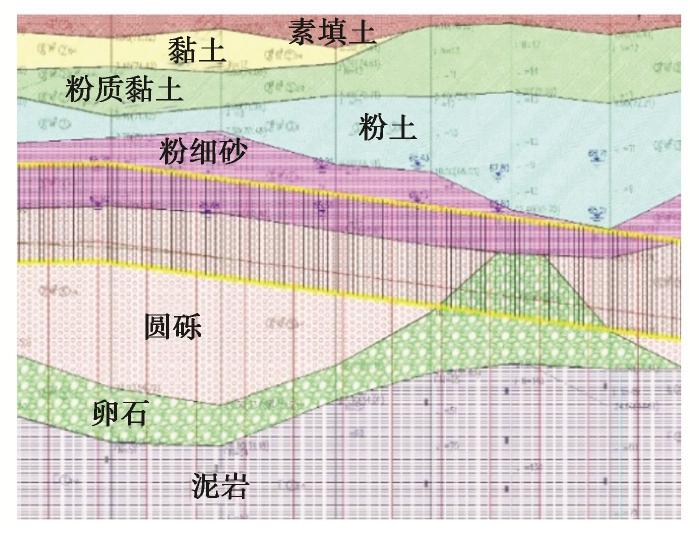
 下载:
下载:
